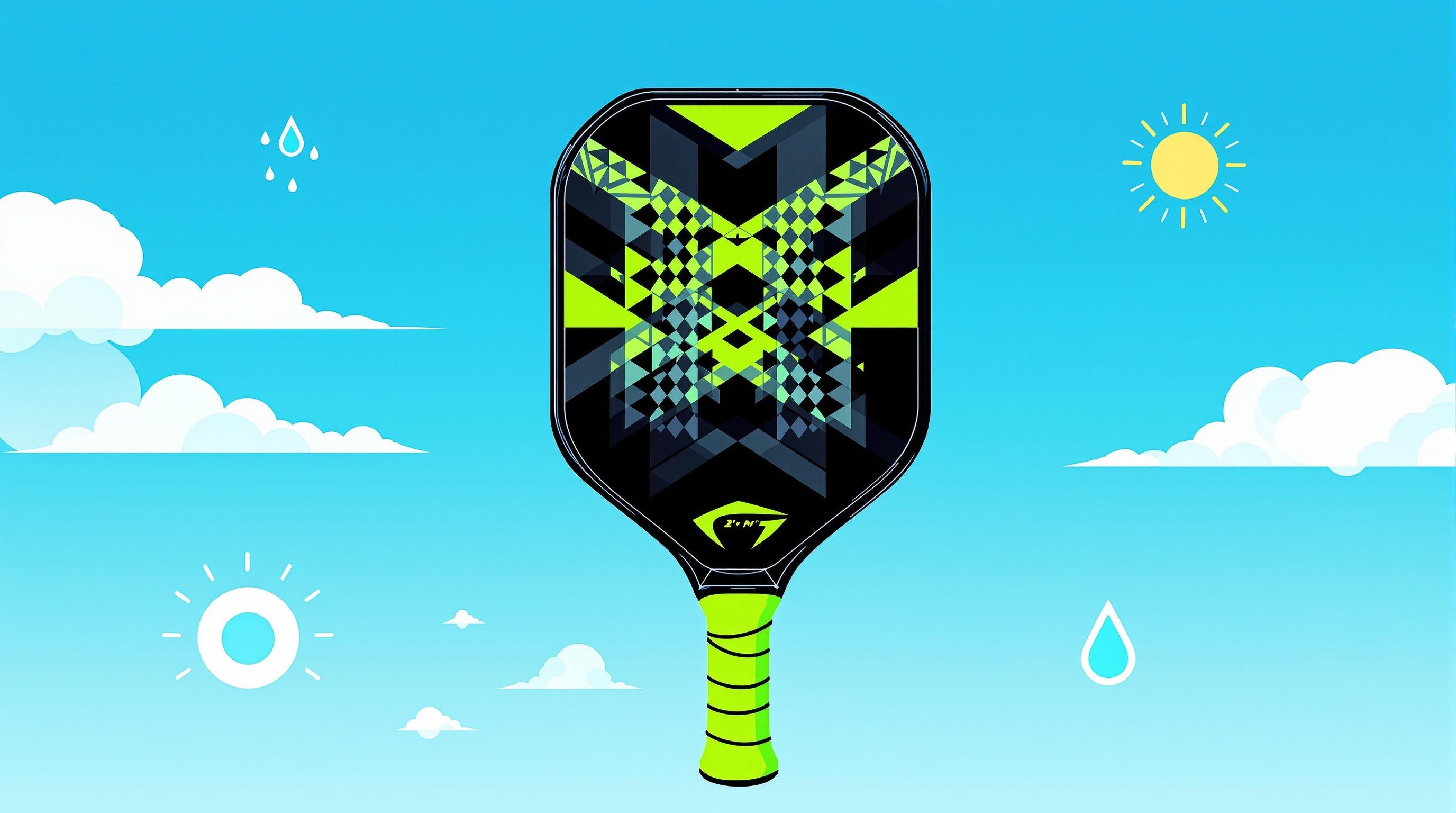Weather can make or break your carbon pickleball paddle. High heat, freezing temperatures, and moisture can damage its structure and performance. Here's what you need to know:
- Heat: Temperatures above 140°F (60°C) can warp the paddle, weaken its resin, and cause delamination. Avoid leaving it in hot cars or direct sunlight.
- Cold: Freezing weather makes paddles brittle, reduces flexibility, and increases impact damage risks. Gradual temperature adjustments help.
- Moisture: Water exposure can weaken the core, separate layers, and reduce responsiveness. Always dry your paddle thoroughly and store it in low-humidity spaces.
Quick Tips to Protect Your Paddle:
- Use insulated or waterproof paddle bags.
- Store in climate-controlled areas (68-72°F).
- Inspect regularly for damage like cracks, warping, or delamination.
Taking these steps ensures your paddle lasts longer and performs consistently, no matter the weather.
How Temperature Affects Paddles, Is Louis 4.5, PPA ...

Temperature Effects on Carbon Fiber
Temperature shifts can impact both the performance and lifespan of carbon fiber paddles.
Heat Damage and Prevention
High temperatures can be tough on carbon fiber paddles. When exposed to heat above 140°F (60°C), the resin holding the fibers together may soften, leading to:
- Warping of the paddle face
- A weaker structure that impacts responsiveness
- Delamination of materials
To minimize heat damage:
- Avoid leaving your paddle in a hot car, where temperatures can reach over 150°F (65°C) during summer
- Store it in a climate-controlled space
- Use an insulated paddle bag for travel
- Keep it out of direct sunlight during breaks
Even though PLAY HENRY's carbon paddles are made with heat-resistant resins, proper care is still essential to maintain their condition.
Cold weather presents a different set of challenges.
Cold Weather Risks
In colder temperatures, carbon paddles face other issues:
- The structure becomes more brittle
- Flexibility and responsiveness decrease
- Increased chances of impact damage
- Condensation problems when moving between warm and cold environments
To protect your paddle in cold conditions:
- Let it adjust gradually to outdoor temperatures
- Keep it dry to avoid freeze-thaw damage
- Avoid sudden temperature changes
Before playing in the cold, warm up your paddle. Store it at room temperature (68-72°F/20-22°C) and allow 15-20 minutes for it to adjust when transitioning outdoors.
| Temperature Range | Effects on Carbon Paddle | Recommended Actions |
|---|---|---|
| Above 140°F (60°C) | High risk of structural damage | Remove from heat immediately |
| 90-140°F (32-60°C) | Moderate risk of warping | Use insulated storage, avoid direct sun |
| 32-90°F (0-32°C) | Optimal performance range | Normal use with standard care |
| Below 32°F (0°C) | Increased brittleness | Transition gradually, handle with care |
Rapid temperature changes can be just as damaging as extreme heat or cold. Always give your paddle time to adjust when moving between different environments.
sbb-itb-c5e004d
Water and Humidity Problems
Moisture can harm both the structure and performance of your paddle. Knowing how water affects your paddle is key to protecting your investment and keeping it in top shape. Below, we break down how damage occurs and share steps to safeguard your gear.
Water Damage to Carbon
Just as temperature stress can weaken a paddle, moisture can also compromise its structure. Here's how:
- Core Weakening: Water seeping through cracks or gaps can damage the paddle's core.
- Layer Separation: Moisture between layers can cause delamination.
- Reduced Performance: A wet core leads to less power and responsiveness.
PLAY HENRY paddles are designed with specialized edge seals to limit water exposure.
| Exposure Level | Observable Effects | Impact on Performance |
|---|---|---|
| Light Exposure | Surface spotting, slight weight gain | Minimal impact |
| Moderate Exposure | Edge swelling, reduced responsiveness | Noticeable power decrease |
| Heavy Exposure | Visible delamination, core softening | Severe performance issues |
| Extended Exposure | Structural failure, permanent damage | Paddle becomes unusable |
Moisture Protection Steps
Protecting your paddle from moisture is straightforward if you follow these steps:
-
Dry Immediately
- After any exposure to water, dry the paddle thoroughly with a microfiber towel, especially around the edges and grip.
- Avoid storing a damp paddle in its case.
-
Control Humidity
- Store your paddle in a space with humidity levels below 60%.
- Add silica gel packets to your paddle bag for extra moisture control.
- Steer clear of damp storage areas like basements or garages.
-
Take Preventive Actions
- Apply a water-repellent coating designed for paddles every few months.
- Regularly inspect the edge seals for any signs of wear or damage.
- Use a waterproof paddle cover when transporting your gear.
Be especially cautious during conditions like early morning dew, after rain, or on humid days. Water spots are more noticeable on monochrome paddles, so quick drying also helps maintain their appearance.
Weather Protection Guide
Taking care of your paddle properly ensures it performs well and lasts longer. Use this guide to keep it in top shape.
Storage Methods
Storing your paddle correctly helps protect it from temperature and humidity changes. For example, PLAY HENRY's carbon paddles retain their sleek monochrome finish when stored under the right conditions.
| Storage Location | Suitability | Reason |
|---|---|---|
| Climate-controlled closet | Excellent | Stable conditions |
| Garage | Poor | Temperature swings |
| Car trunk | Very Poor | Extreme temperatures |
| Basement | Poor | High humidity |
Basic Maintenance Steps
-
Daily Care
After every use, wipe your paddle with a microfiber cloth to remove moisture and debris. Pay special attention to cleaning the grip to prevent moisture buildup. -
Weekly Check
Inspect the paddle for any edge seal issues, surface cracks, or changes in firmness. Test the paddle face to ensure it responds as expected. -
Monthly Care
Apply a protective coating to carbon fiber paddles, check the condition of the grip, and examine the paddle case for any wear or damage.
Sticking to this routine helps maintain performance and catch early signs of weather-related damage.
Signs of Weather Damage
Weather exposure can take a toll on your paddle. Here’s what to look for:
| Damage Type | Visual Indicators | Performance Impact |
|---|---|---|
| Heat Stress | Surface bubbling, warped edges | Reduced power transfer |
| Cold Damage | Brittle feel, micro-cracks | Inconsistent rebounds |
| Moisture Issues | White spots, layer separation | Deadened sweet spot |
| UV Exposure | Faded finish, rough texture | Surface deterioration |
If you spot any of these issues, especially on carbon fiber paddles, act quickly to address them. While minor surface damage can sometimes be fixed, severe structural problems caused by weather typically mean it’s time for a replacement.
Conclusion
To keep your carbon paddle performing at its best, it’s essential to stay mindful of how weather affects it. Temperature extremes and moisture can impact both the durability and performance of your paddle.
Extreme heat or cold can weaken the paddle's structure. PLAY HENRY's carbon paddles, known for their sleek monochrome design, retain their quality and performance when properly protected from harsh conditions.
Consistent care and smart storage are key. Protect your paddle by storing it in a controlled environment, addressing any damage promptly, and performing regular maintenance. These steps will help extend its lifespan and ensure reliable performance.

